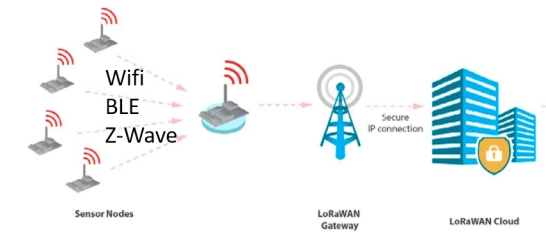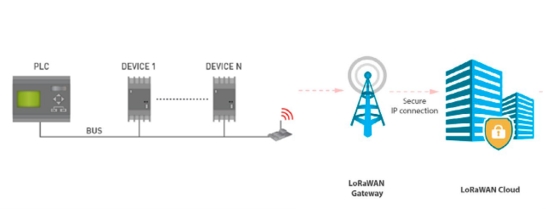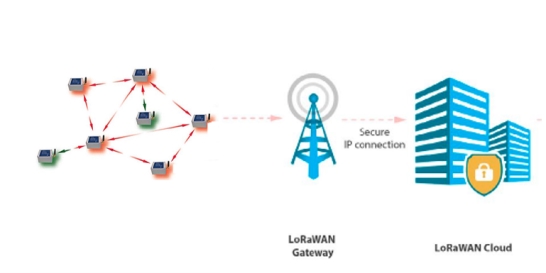Choosing the right connectivity option
Robust and economical connectivity is critical for the Internet of Things. Usually wireless connections are used. In some situations, like connecting PLCs (Programmable Logic Controllers), a hybrid approach combining wired and wireless is a good solution.
Every situation is different and the “right” wireless answer needs to take into account the options actually available, total costs, how much data needs to be transferred, power demand placed on the connected object, and the distance of the connected object.
| Choice | Characteristics | Examples |
|---|---|---|
| Cellular | High data rate, high power |
Pictures and audio Live video |
| Wifi | High data rate, limited range, high power |
Home automation Personal devices |
| RFID, Bluetooth ZigBee, NFC |
Short range, low power |
Wearables Home automation |
| KotahiNet LPWAN | Low data rate, long range, low power |
Precision agriculture Remote locations |
The connectivity gap that KotahiNet fills is low power over long distances for sensors and other smart objects that only need low data rates. Technically, this is called LPWAN (Low-Power Wide-Area Network) and is expected to be half of the Internet of Things connectivity market in the future.
The specific LPWAN technology being deployed by KotahiNet is LoRaWAN. KotahiNet’s network is the right choice when low data rate, long range, and low power are the key criteria.
LoRaWAN vs. Sigfox
Both LoRaWAN and Sigfox provide wireless data connectivity for the long range, low power segment. We welcomed Sigfox to New Zealand as a way of providing greater understanding and interest in LPWAN technologies.
However, LoRaWAN and Sigfox are very different technologies and business models. The table below highlights some of these.
| Dimension | LoRaWAN | Sigfox |
|---|---|---|
| Technology | Spread spectrum | Ultra-narrowband |
| Proprietary component | Radio (LoRa) is Semtech proprietary Network (LoRaWAN) is open specifications |
Physical layer and network are both proprietary to Sigfox |
| Allowed end devices | No restrictions | Only Sigfox certified |
| Payload length | No restrictions (multiple messages if payload exceeds 100 bytes) | Maximum 12 bytes |
| Messages limitation | No restrictions | Maximum 140 per day |
| Data/commands to end devices | No restrictions | Difficult/impossible. Maximum 8 bytes payload |
| Network operator | Autonomous networks, one or more per country | Exclusive country licensing (in some operated by Sigfox itself) |
| Inter-networks roaming | Currently limited but improving | Easier but requires customisation to each of 4 zones globally |
| NZ frequencies | 865 MHz | 920.8 MHz Uplink 922.3 MHz Downlink |
Hybrid Networks
Usually sensors and other end devices in KotahiNet’s network connect to our gateway using the LoRaWAN network protocol. There are a few situations where they instead connect to an intermediate device or concentrator and that then connects to our gateway.
There are three scenarios where this hybrid approach is recommended:
1. There are lots of sensors in close proximity to each other or there is an existing wireless network to which these sensors connect. The sensors to intermediate device can use any wireless option such as Wifi, BLE, Z-Wave, private 433 MHz network, etc. The intermediate device will collect all the data and transmit it using LoRaWAN to the gateway.
In the future, the intermediate device could also be a network edge device as part of a fog computing system that undertakes local storage, processing and analytics.
An intermediate device such as LoPy that has wifi, BLE and LoRa on a single board is a good choice.

Wireless local network + LoRaWAN
2. There is a wired network in place, such as that connecting PLCs (Programmable Logic Controllers), which needs to connect wirelessly to the Internet via KotahiNet.
The wired network could run CAN bus or M-bus. Solutions include AMIHO’s AM094 which has WMBus and LoRa on a single board or a dual Modbus and LoRa using a Waspmote.

Wired network + LoRaWAN
3. There’s interest in running a peer-to-peer or mesh network with one node connecting to KotahiNet’s gateway. The local network could use LoRa or any wireless mesh network technology and the connecting node will use LoRaWAN.

Mesh + LoRaWAN
![]()
Also see Network, Use Cases, Technology, and Sending Data.
